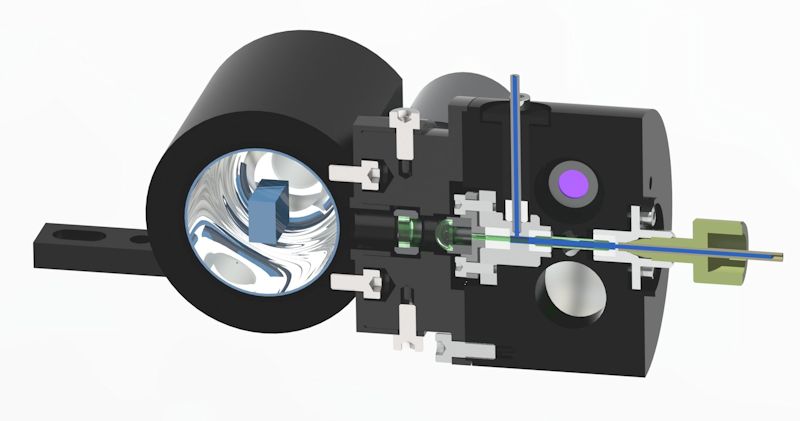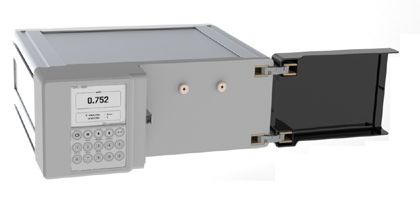A fluorometric detector in a liquid chromatograph is designed to quantify the concentration of substances by the intensity of their fluorescence, which occurs under the influence of ultraviolet radiation of a certain wavelength. Most often in analytical laboratory practice, fluorometric detectors are used to quantify the following substances:
- polyaromatic hydrocarbons (PAHs) in food, beverages and drinking water
- aflatoxins B1, B2, G1 and G2 in food products
- aflatoxin M1 in milk and dairy products
- ochratoxin A in wine, juices and soft drinks
- OPA-and other fluorescent amino acid derivatives in various samples
- a large number of fluorescent substances in chemical and pharmaceutical laboratories and industries
The fluorometric detectors available on the chromatographic equipment market typically use a high-pressure xenon lamp as a light source. To select the desired wavelength, either a monochromator with electronic-mechanical adjustment of the diffraction grating or a set of interference filters are used. The service interval of operation of such devices depends on the resource of stable operation of the radiation source, which for modern xenon lamps ranges from 1000 to 2000 hours. In addition, they need to intensive forced cooling and the use of complex electron-optical systems to stabilize the operation of the light source, which, in turn, negatively affects the stability of the device as a whole. The use of a monochromator or light filters as a wavelength selector leads to a significant reduction in the radiation power in the analytical cell. Frequently used monofilament light guides also reduce the amount of light delivered to the cell.

When creating a fluorimetric detector for the Steyer-M line, a different approach was chosen. As a result of the use of switchable LED sources of ultraviolet radiation, we were able to dramatically increase the reliability, ease of maintenance and reparability while maintaining the main technical and analytical characteristics. The special design of the cuvette allows operation at a pressure of up to 30 bar. The low-noise photomultiplier provides increased sensitivity and improved signal-to-noise ratio.
The DFL-203 is a compact and reliable detector with LED fluorescence excitation. There is no moving part in the detector design, except for the switching mechanism of the cut-off filters. The device is available with pre-installed LEDs at 280/365 nm or 255/365 nm, which allows you to solve almost any analytical tasks. By special order, the device can be supplied with other pairs of exciting LEDs. The detector design is protected by Russian and international patents.
Features and Benefits
- The minimum number of optical and mechanical elements leads to increased reliability and stability of the device.
- Optical cuvette materials allow the use of solvents with pH from 0 to 14.
- The use of highly stable semiconductor light sources ensures low noise and a long service life of the device with constant characteristics.
- Quick access to the operating mode, in most cases up to 5 minutes.
- Possibility of manual and program control.
- Ability to work with third-party software via the RS-232 port.
- Ability to connect an external ADC via an analog output.
- The unique parameters of the maximum operating pressure in the cell (30 bar) make it possible to work with external hydroresistance (suppression of the formation of large air bubbles in the liquid path with undegassed or insufficiently degassed eluent).
- The fluorescence excitation wavelengths are 280 and 365 nm or 255 and 365 nm. By special order, it is possible to install LEDs with a different wavelength.
- Maximum flow rate through the cuvette - 10 ml/min.
- Detectable volume - 10 µl.
- Ability to work from power supply networks of various voltages (100-240 V).
- Minimum power consumption (20 W).
| Anthracene detection limit, g | 1·10-14 |
| Wavelengths of light sources (two monochromatic LEDs), nm |
280 & 365 255 & 365* |
| Detectable volume, µl | 10 |
| Maximum flow rate through the cuvette, ml/min | 10 |
| Maximum pressure in the optical cell, bar | 30 |
| Operating time, min, max | 10 |
| Spectral range of measurement, nm | 330 - 400 400 - 600 |
| Signal averaging time, sec | 0,5; 1,0; 2,0 |
| Eluent pH range, pH units | 0 - 14 |
| Remote update of the microprocessor software | yes |
| Interfaces | Aquilon BUS, RS-232, USB, analog output |
| Power supply, voltage/frequency | 110-220 V / 50 Hz |
| Power consumption, VA, maxе | 20 |
* A different combination of LEDs is possible depending on the analytical tasks being solved.


